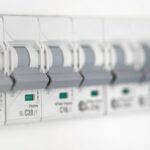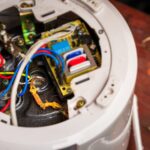Imagine a world where every electrical appliance in your home operates safely, without the looming threat of electrical faults or hazards. Grounding wires are vital components in achieving this safety, connecting your home’s electrical system to the earth for the ultimate protection. Grasp the significance of proper grounding wire installation and unlock the keys to electrical safety for your home.
- Understand the vital role of grounding wires in preventing electrical hazards and ensuring home safety.
- Discover essential tools and materials that lead to successful grounding wire installation, ensuring optimal safety and performance.
- Follow a clear step-by-step guide designed to help you safely and effectively install grounding wires.
- Learn how to avoid common pitfalls that can compromise both safety and the efficiency of your grounding system.
As you delve into this article, you’ll gain insightful knowledge and practical advice, arming yourself with the information needed to fortify your home against electrical mishaps. Your journey to safer electrical systems starts here, empowering you to take control and contribute to a secure living environment.
Understanding the Basics: Grounding Wire Installation Explained
Grounding wire installation is a critical component of electrical safety in any home. A grounding wire, often referred to as an earth wire, essentially directs any excess electrical current safely into the ground, significantly reducing the risk of electric shock or fire.
The purpose of a grounding wire is to stabilize voltage levels, preventing electrical surges by serving as a reference point that maintains a uniform voltage throughout the system. This is particularly vital when there are power fluctuations or during a lightning storm.
Proper grounding not only ensures the safety of home inhabitants but also protects electrical appliances from damage. It meets specific standards and regulations, such as the National Electrical Code (NEC) in the United States, which dictates the guidelines for correct installation and use, ensuring that installations are safe and effective.
Grounding wire standards call for specific wire sizes and materials, emphasizing copper as the preferred choice due to its conductivity and durability. Understanding the foundational principles of grounding wire installation empowers homeowners and professionals alike to safeguard their electrical systems effectively.
Tools and Materials Needed for Effective Grounding
Embarking on a grounding wire installation requires specific tools and materials that ensure safety and efficiency. It is essential to use the right tools to achieve a secure and lasting connection.
A well-stocked toolkit should include:
- Wire strippers: These are used for removing insulation from the wire, ensuring a clean connection.
- Screwdrivers: A set of screwdrivers is necessary for securing connections and attaching the grounding wire to various points.
- Multimeter: This tool helps measure electrical current, ensuring that the grounding is functioning properly.
- Pliers: Used for cutting and bending wires as needed during installation.
When selecting materials for grounding, opting for high-quality copper wire ensures optimal conductivity and longevity. It is also advisable to choose corrosion-resistant grounding clamps and rods to secure the wire appropriately.
Investing in quality components not only assures a safer home environment but also minimizes maintenance needs over time, making grounding wire installation a worthy aspect of any electrical system upgrade.
Step-by-Step Guide to Grounding Wire Installation
Installing a grounding wire is a crucial task that ensures electrical safety in your home. Understanding each step is vital for successful implementation. Whether you’re a seasoned professional or a DIY enthusiast, this guide will walk you through the process with ease.
Before you begin, make sure you have the necessary tools and materials ready. These include insulated pliers, a voltage tester, and ground rods. Begin by turning off the main power supply to the area where you’ll be working. Safety should always be your priority.
Locate the Grounding Point: Identify a suitable location for your grounding rod, typically near the main electrical panel. The ground should be soft enough to drive the rod into it.
Install the Grounding Rod: With a hammer, drive the ground rod into the earth until only about eight inches remain above ground. This provides a reliable connection to the ground.
Connect the Grounding Wire: Securely attach the grounding wire to the rod using a grounding clamp. Ensure there is no slack in the wire, as this can affect conductivity.
Wire to the Electrical Panel: Run the other end of the grounding wire to the main electrical panel. Attach it to the neutral bus bar found inside the panel. This step completes the ground path.
Finally, double-check all connections. Use a voltage tester to confirm that the current flow is grounded correctly. Reconnect the power supply, knowing that your electrical system is now safely grounded.
Common Mistakes to Avoid During Grounding Wire Installation
Proper grounding wire installation is essential to maintain safety and functionality in your home’s electrical system. However, several common mistakes can undermine these efforts.
Incorrect Grounding Rod Placement: One frequent error is placing the grounding rod too close to foundations or other structures. This can impede its effectiveness. Ensure you select a site free from obstructions.
Improper Grounding Wire Connection: A loose or inadequate connection to the grounding rod or electrical panel can cause failures. Always check that all connections are secure and tight.
Using Inappropriate Materials: Using undersized or low-quality grounding wire can affect conductivity. Opt for high-grade copper wire to ensure optimal performance.
Neglecting Regular Maintenance: Over time, connections can become loose due to environmental factors. Regular inspections and maintenance are vital to catch and repair issues early.
By avoiding these common pitfalls, you can ensure a safe and effective grounding wire installation. Maintaining attention to detail throughout the process will safeguard your home from potential electrical hazards.
Maintenance Tips for Long-Lasting Grounding Wire Systems
Ensuring the longevity and effectiveness of your grounding wire system requires regular maintenance and vigilant monitoring. Proper upkeep not only optimizes performance but also fortifies your home against electrical faults, safeguarding both your appliances and inhabitants.
Regular Inspections are Key
Begin by conducting periodic inspections of your grounding wire installation. Look for any signs of wear and tear, such as frayed wires or corrosion. Spotting these issues early can help prevent more significant problems. Regular checks can alert you to swift deterioration, which could compromise electrical safety.
Secure Connections
Check all grounding connections to ensure they are tight and secure. Loose connections can lead to ineffective grounding. It is essential to routinely tighten any connections that may have loosened over time due to changes in temperature or physical disturbances.
Avoid Excess Moisture
Moisture is a common adversary to grounding wire systems. Ensure that your grounding setup is adequately protected from exposure to water. Excessive moisture can lead to rust and corrosion, which weaken the connections and wire integrity.
Use High-Quality Materials
When repairing or replacing components of your grounding system, always opt for high-quality materials. Using top-grade copper wires and brass fittings can enhance conductivity and decrease the likelihood of future issues.
Adapt to Environmental Changes
Consider the implications of any environmental changes around your home. Nearby construction or landscaping alterations can impact your grounding wire system. Adapting your system to these changes can preempt potential disruptions.
By following these maintenance tips, you will not only ensure a robust grounding system but also contribute to the ongoing safety and integrity of your home’s electrical infrastructure. Engaging in these practices routinely will help avoid common pitfalls and extend the lifespan of your grounding installation.
Frequently Asked Questions about Grounding Wire Installation
Why is grounding wire installation important?
Grounding wire installation is crucial for preventing electrical shocks and fires by providing a safe path for excess electricity to dissipate.
What does a grounding wire do?
A grounding wire carries any excess electrical current safely into the ground to prevent electrical hazards.
What tools are needed for grounding wire installation?
- Screwdriver
- Wire cutter
- Voltage tester
- Safety gloves
Can I install a grounding wire myself?
Yes, with the right tools and knowledge, but it’s recommended to consult a professional for safety.
How do I know if my grounding wire is working?
Use a voltage tester to confirm there is no electrical current in the grounding wire under normal conditions.
What are common mistakes during installation?
Using wrong materials, improper connections, and failing to secure the wire properly are common mistakes.
How often should grounding systems be inspected?
Inspect grounding systems annually to ensure they remain effective and secure.





